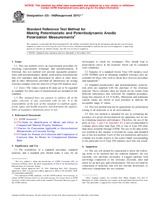We need your consent to use the individual data so that you can see information about your interests, among other things. Click "OK" to give your consent.
ASTM G5-94(2011)e1
Standard Reference Test Method for Making Potentiostatic and Potentiodynamic Anodic Polarization Measurements (Includes all amendments And changes 3/4/2013).
Automatically translated name:
Standard Reference Test Method for Making Potentiostatic and Potentiodynamic Anodic Polarization Measurements
STANDARD published on 15.11.2011
The information about the standard:
Designation standards: ASTM G5-94(2011)e1
Note: WITHDRAWN
Publication date standards: 15.11.2011
SKU: NS-57717
The number of pages: 12
Approximate weight : 36 g (0.08 lbs)
Country: American technical standard
Category: Technical standards ASTM
Annotation of standard text ASTM G5-94(2011)e1 :
Keywords:
anodic polarization, electrochemical testing, pitting, potentiodynamic, potentiostatic, sulfuric acid, Type 430 stainless steel, ICS Number Code 71.040.50 (Physicochemical methods of analysis)
Additional information
| Significance and Use | ||||||||
|
The availability of a standard procedure, standard material, and a standard plot should make it easy for an investigator to check his techniques. This should lead to polarization curves in the literature which can be compared with confidence. Samples of a standard ferritic Type 430 stainless steel (UNS S43000) used in obtaining standard reference plot are available for those who wish to check their own test procedure and equipment. Standard potentiostatic and potentiodynamic polarization plots are supplied with the purchase of the reference material. These reference data are based on the results from different laboratories that followed the standard procedure, using that material in 1.0 N H2SO4. Maximum and minimum current values are shown at each potential to indicate the acceptable range of values. This test method may not be appropriate for polarization testing of all materials or in all environments. This test method is intended for use in evaluating the accuracy of a given electrochemical test apparatus, not for use in evaluating materials performance. Therefore, the use of the plots in Figs. 1 and 2 or Appendix X2 is not recommended to evaluate alloys other than Type 430, or lots of Type 430 other than those available through ASTM. The use of the data in this test method in this manner is beyond the scope and intended use of this test method. Users of this test method are advised to evaluate test results relative to the scatter bands corresponding to the particular lot of Type 430 stainless steel that was tested. CURRENT DENSITY (μA/cm2) CURRENT DENSITY (μA/cm2) |
||||||||
| 1. Scope | ||||||||
|
1.1 This test method covers an experimental procedure for checking experimental technique and instrumentation. If followed, this test method will provide repeatable potentiostatic and potentiodynamic anodic polarization measurements that will reproduce data determined by others at other times and in other laboratories provided all laboratories are testing reference samples from the same lot of Type 430 stainless steel. 1.2 Units—The values stated in SI units are to be regarded as standard. No other units of measurement are included in this standard. 1.3 This standard does not purport to address all of the safety concerns, if any, associated with its use. It is the responsibility of the user of this standard to establish appropriate safety and health practices and determine the applicability of regulatory limitations prior to use. |
||||||||
| 2. Referenced Documents | ||||||||
|
We recommend:
Technical standards updating
Do you want to make sure you use only the valid technical standards?
We can offer you a solution which will provide you a monthly overview concerning the updating of standards which you use.
Would you like to know more? Look at this page.




 Cookies
Cookies
